Analyzing the Problems of a District-Based Administration Using Monte Carlo Simulation: The Case of Sex Offender Notifications in Korea
Abstract
:1. Introduction
2. Data and Study Area
3. Methodology
3.1. Number of Sex Offenders by Distance
3.2. k-Nearest Neighbor
3.3. Vulnerability Statistics 1: Notification Rate
3.4. Vulnerability Statistics 2: Distance
3.5. Monte Carlo Simulation
- Step 1. Generate sex offender residence points randomly in the residential areas within Seoul.
- Step 2. For the generated random residence points, calculate the notification rate (or distance to a sex offender whose information has not been distributed).
- Step 3. Repeat steps 1 and 2 a total of 999 times.
- Step 4. Sort the calculated statistics from all random samples from the lowest to highest.
- Step 5. Derive a 95% confidence interval for each model by removing the bottom-50 observations.
- Step 6. If the actual sex-offender-residence-based analysis results fall within the 95% confidence interval of the randomly generated residence-based results, the level of notification problems is considered similar for the two residence types.
4. Results
4.1. Number of Sex Offenders by Distance
4.2. k-Nearest Neighbor
4.3. Vulnerability Statistics 1: Notification Rate
4.4. Vulnerability Statistics 2: Distance
4.5. Monte Carlo Simulation
5. Discussion
6. Conclusions
Author Contributions
Funding
Data Availability Statement
Conflicts of Interest
References
- Kim, K.W. “Nothing Has Changed Since the ASF Outbreak” … Administrative Convenience Standards Still Remain. Korea Farmers and Fishermen Newspaper. 2021. Available online: https://www.agrinet.co.kr/news/articleView.html?idxno=303781 (accessed on 25 May 2024).
- Lee, I.H. There Are No Cases of Quarantine Policies at the Administrative District Unit. Livestock Newspaper. 2019. Available online: http://chuksannews.co.kr/mobile/article.html?no=215763 (accessed on 25 May 2024).
- Yoon, S.J. Association of Swine Veterinarians ‘ASF Stamping out and Movement Restriction Period Must Be Reduced’. DailyVET. 2022. Available online: https://www.dailyvet.co.kr/news/policy/164980 (accessed on 25 May 2024).
- Park, J.H. [National Fire Service Inspector General] Jaeho Park “The Fire Department Should Be Designated as a Distance, Not an Administrative District”. Fire Prevention News. 2020. Available online: https://www.fpn119.co.kr/144789 (accessed on 25 May 2024).
- Song, B.H. Nuclear Disaster Manual, in Case of an Accident, a ‘Further’ Fire Department Responds. Energy Daily. 2020. Available online: http://www.energydaily.co.kr/news/articleView.html?idxno=112535 (accessed on 25 May 2024).
- Jo, D.E. ‘Nuclear Disaster Manual’ That Require the Fire Departments Further away to Respond Should Be Reorganized. Today Energy. 2020. Available online: http://www.todayenergy.kr/news/articleView.html?idxno=229657 (accessed on 25 May 2024).
- Kim, J.Y.; Jung, S. Geographical Profiling of Serial Rape in Korea. Korean J. Public Saf. Crim. Justice 2011, 20, 37–58. [Google Scholar]
- Gu, M.J. [Exclusive] 44% of Sex Offenders in Seoul Live in Child Protection Areas. Weekly Newsmagazine. 2023. Available online: http://www.sisajournal.com/news/articleView.html?idxno=253854#google_vignette (accessed on 25 May 2024).
- Ahn, Y.H. A Study on the Probabilistic Decision Model of the Overseas Railway Investment Project Applying Monte Carlo Simulation. Ph.D. Thesis, Woosong University, Daejeon, Republic of Korea, 2019; pp. 28–32. [Google Scholar]
- Heo, C.K.; Jung, C.K. The strategic decision-making of volleyball game using Monte-Carlo Simulation. Korean Soc. Sports Sci. 2023, 32, 739–749. [Google Scholar]
- Kim, S.G. A Study on Teaching of Probability and Expectation Using Computer Simulation Program (Interactive Probability). Master’s Thesis, Korea National University of Education, Cheongju, Republic of Korea, 1999; pp. 9–12. [Google Scholar]
- Lee, Y.S. A Study of CO2 Emissions per Vehicle on Roads Using Monte Carlo Simulation. Master’s Thesis, Kyonggi University, Suwon, Republic of Korea, 2012; pp. 17–18. [Google Scholar]
- Shin, J.Y.; Lee, G.J. Research on application of spatial statistics for exploring spatio-temporal changes in patterns of commercial landuse. J. Korean Geogr. Soc. 2007, 42, 632–647. [Google Scholar]
- Manly, B.F.J. Randomization, Bootstrap and Monte Carlo Methods in Biology; Chapman and Hall: London, UK, 2006. [Google Scholar]
- Martin, A. Testing for similarity in area-based spatial patterns: A nonparametric Monte Carlo approach. Appl. Geogr. 2009, 29, 333–345. [Google Scholar]
- Seol, Y.J.; Jung, S.B.; Song, K.H.; Chon, K.S.; Rhee, S.M. A evaluation model of AHP results using Monte Carlo Simulation (Depending on the case studies of road and rail). Korean Soc. Transp. 2008, 26, 195–204. [Google Scholar]
- Besag, J.; Diggle, P.J. Simple Monte Carlo tests for spatial pattern. Appl. Stat. 1977, 26, 327–333. [Google Scholar] [CrossRef]
- Diggle, P. Statistical Analysis of Spatial Point Patterns; Arnold: London, UK, 2003. [Google Scholar]
- Loosmore, N.B.; Ford, E.D. Statistical inference using the G or K point pattern spatial statistics. Ecology 2006, 87, 1925–1931. [Google Scholar] [CrossRef]
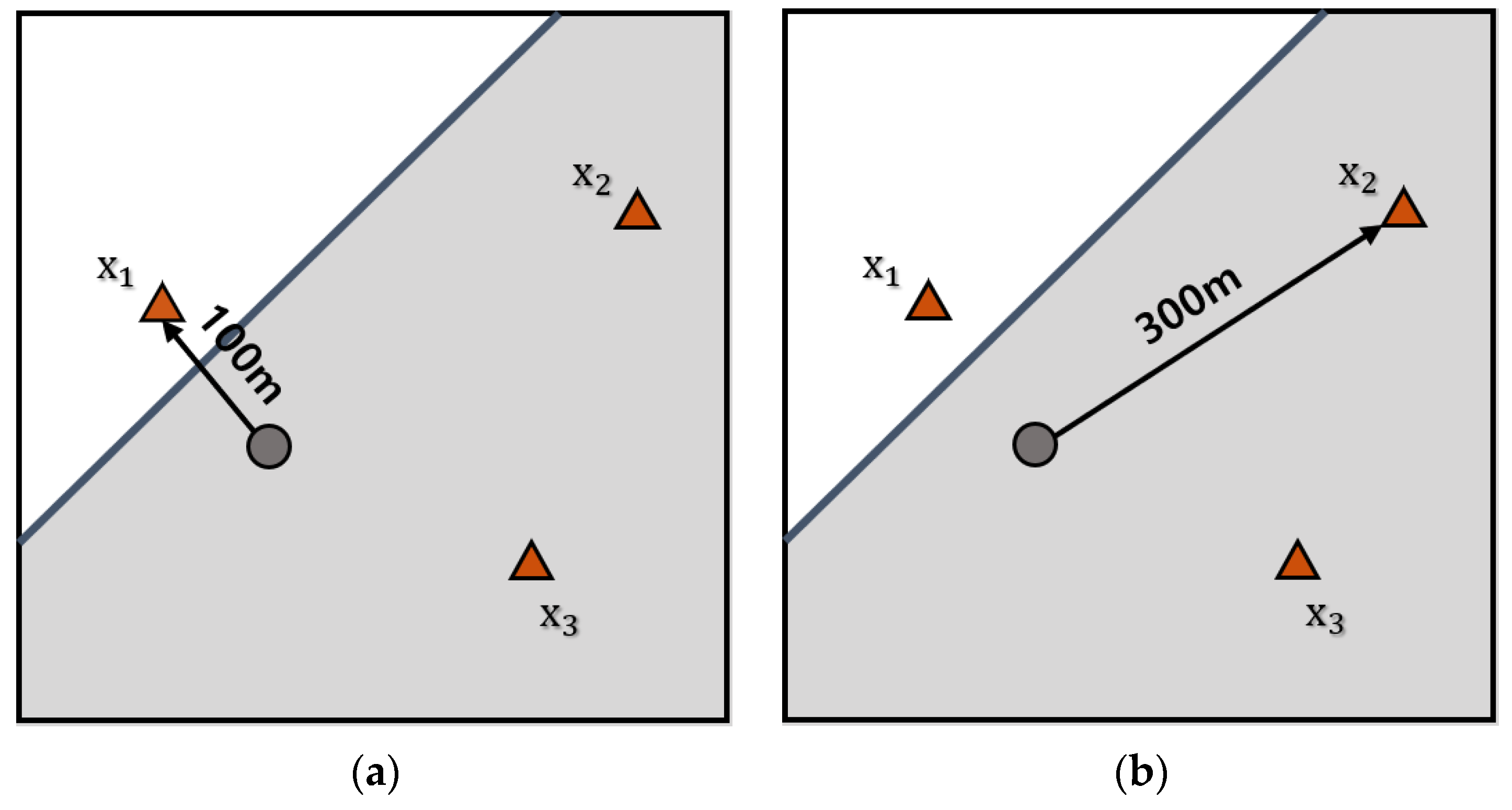
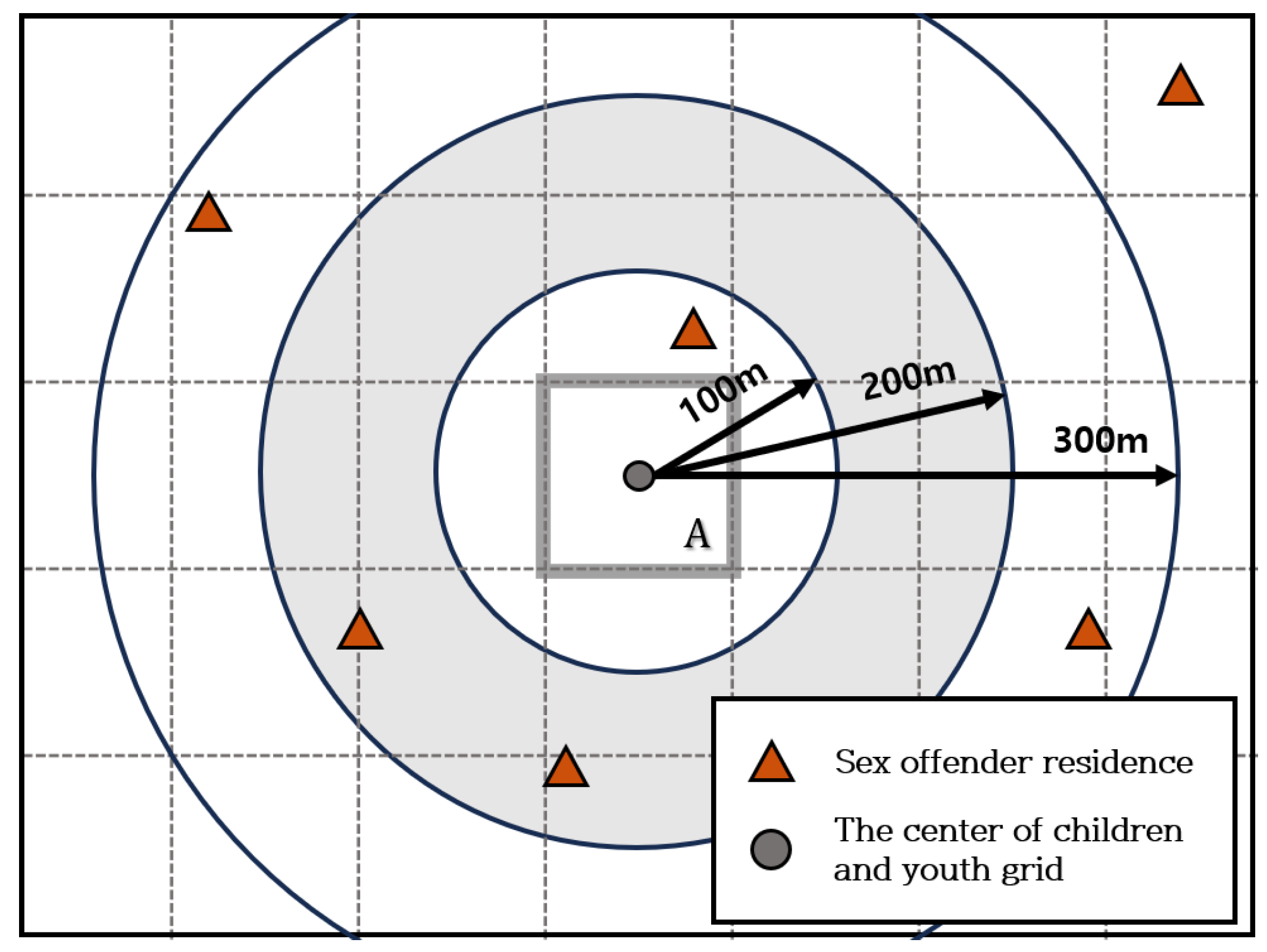

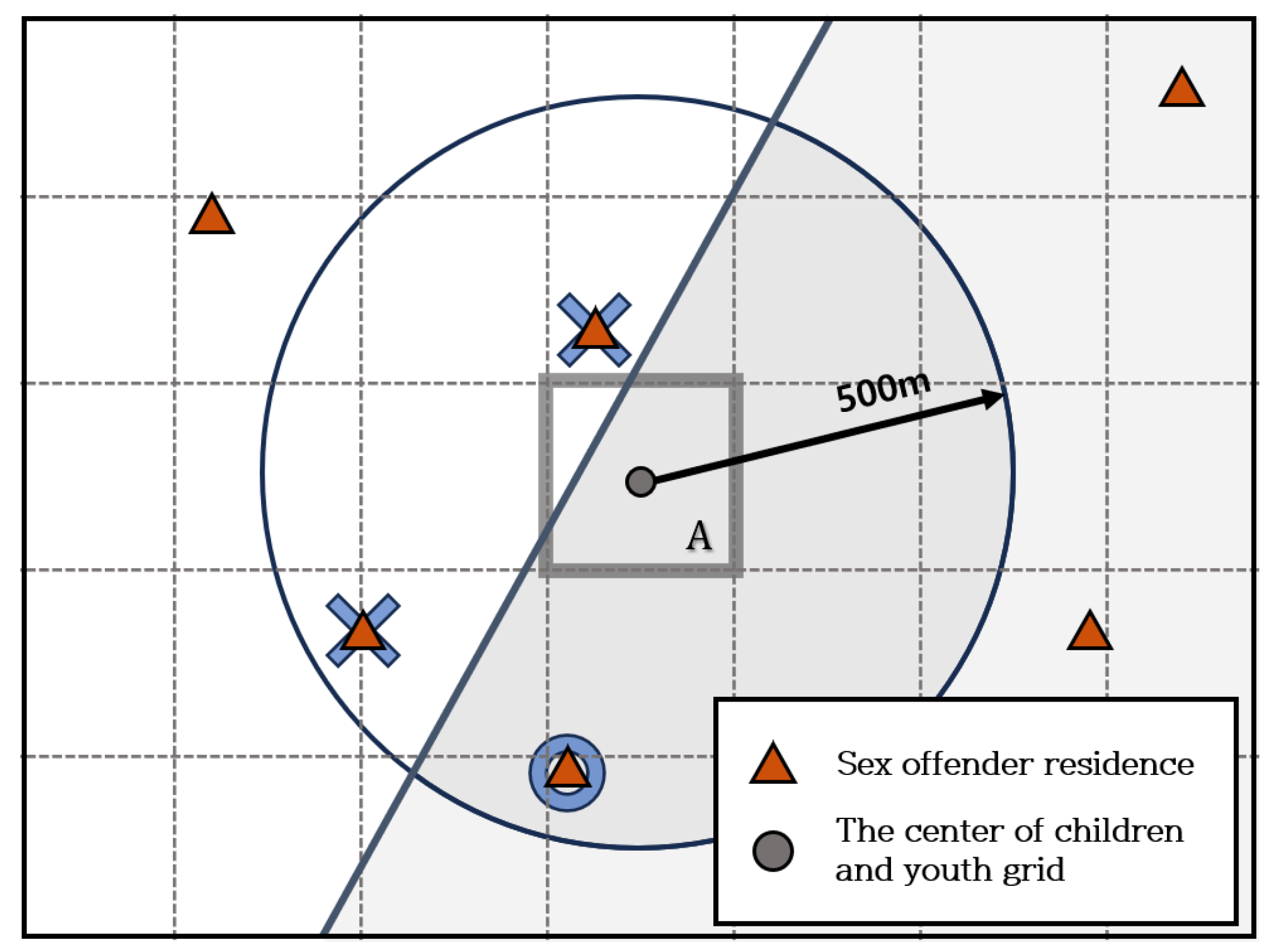
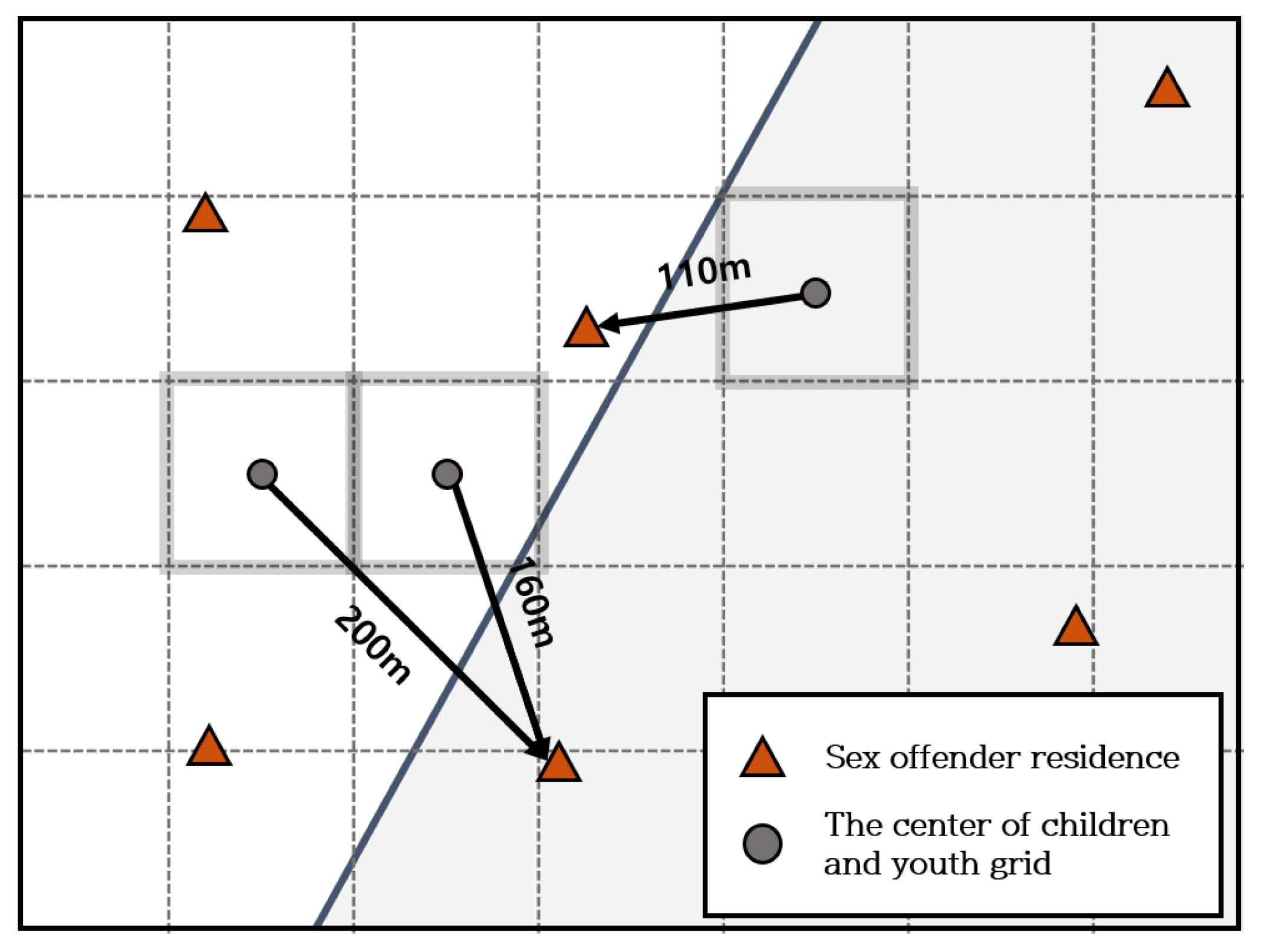
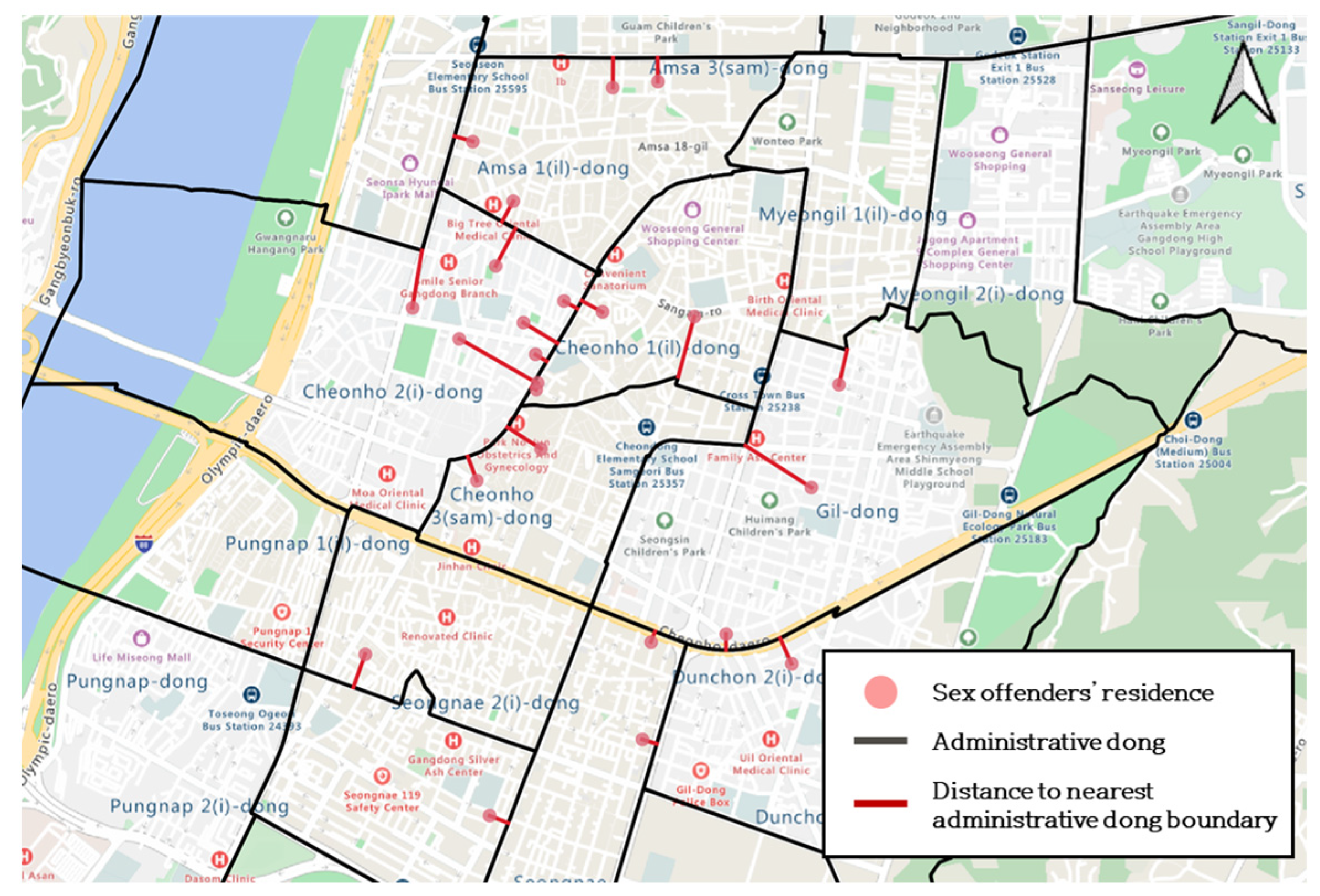
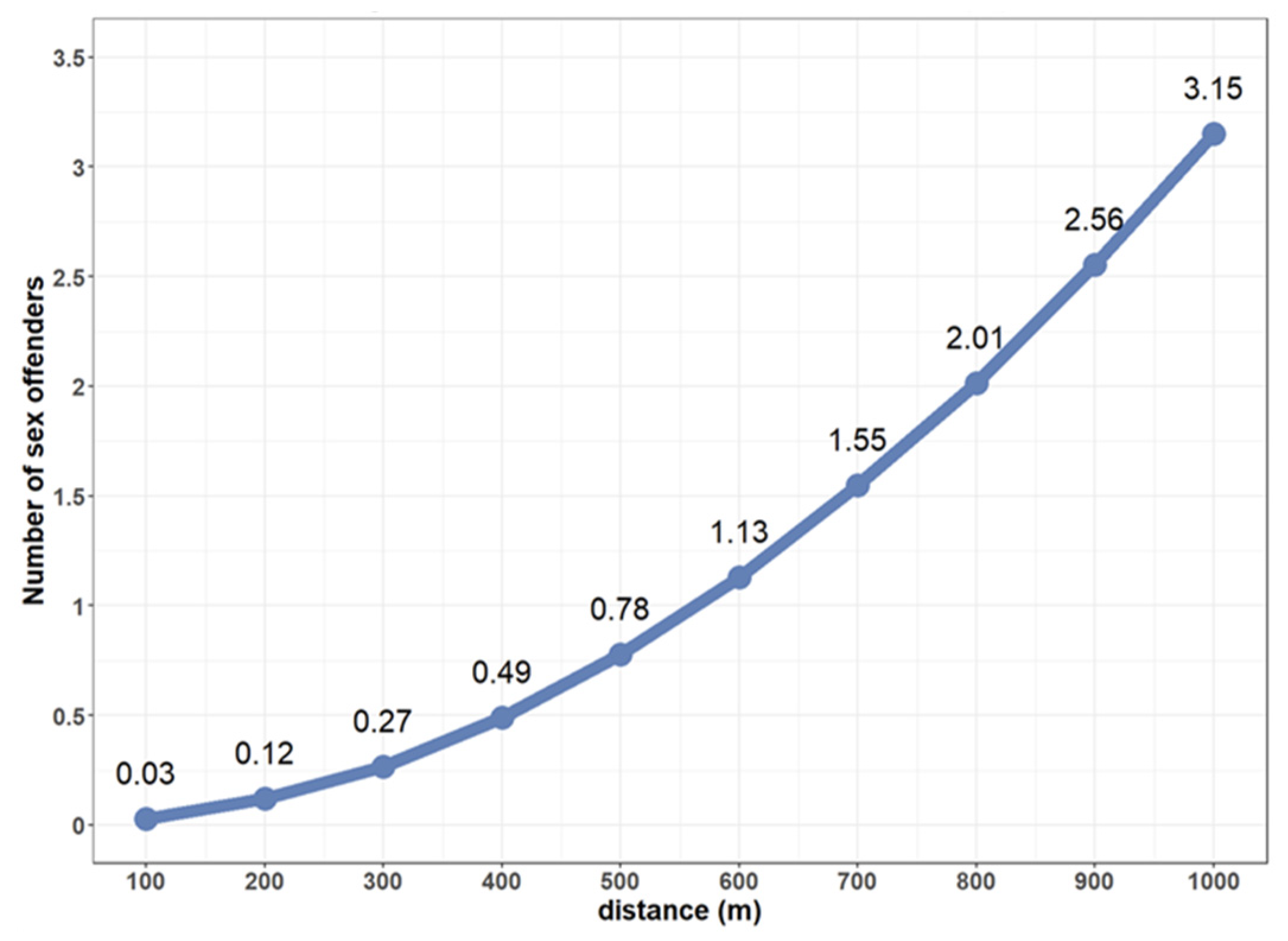


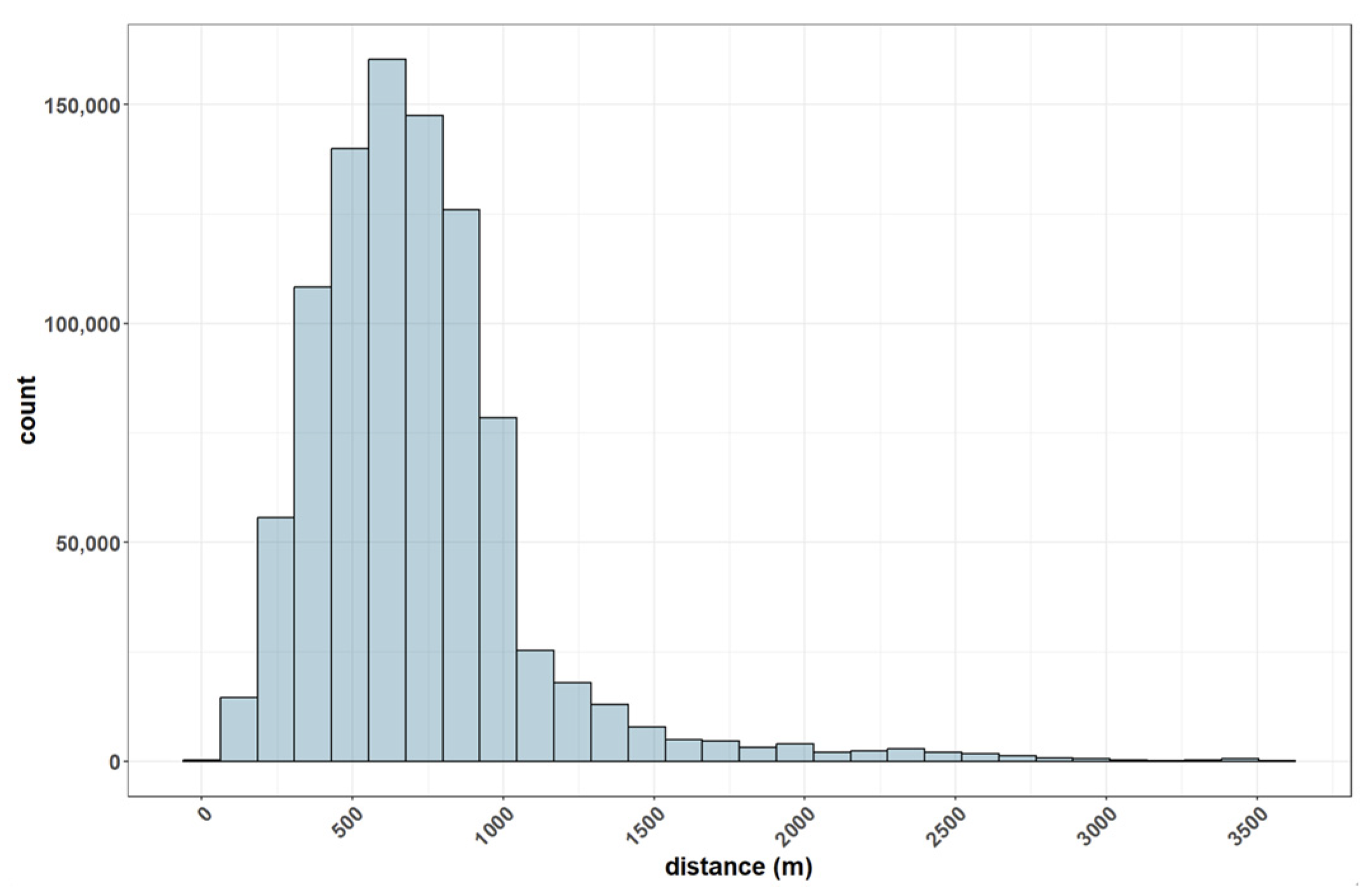
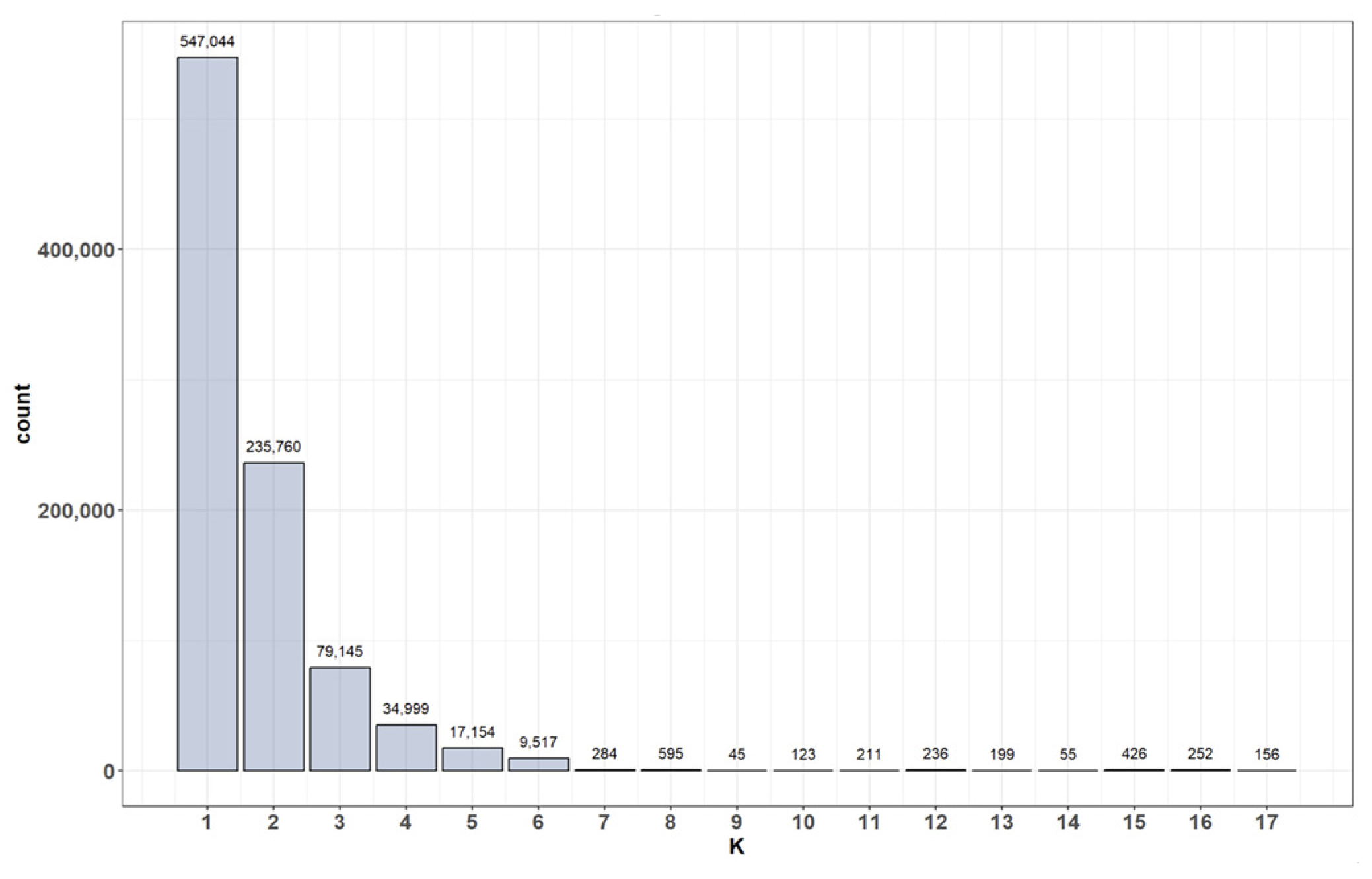
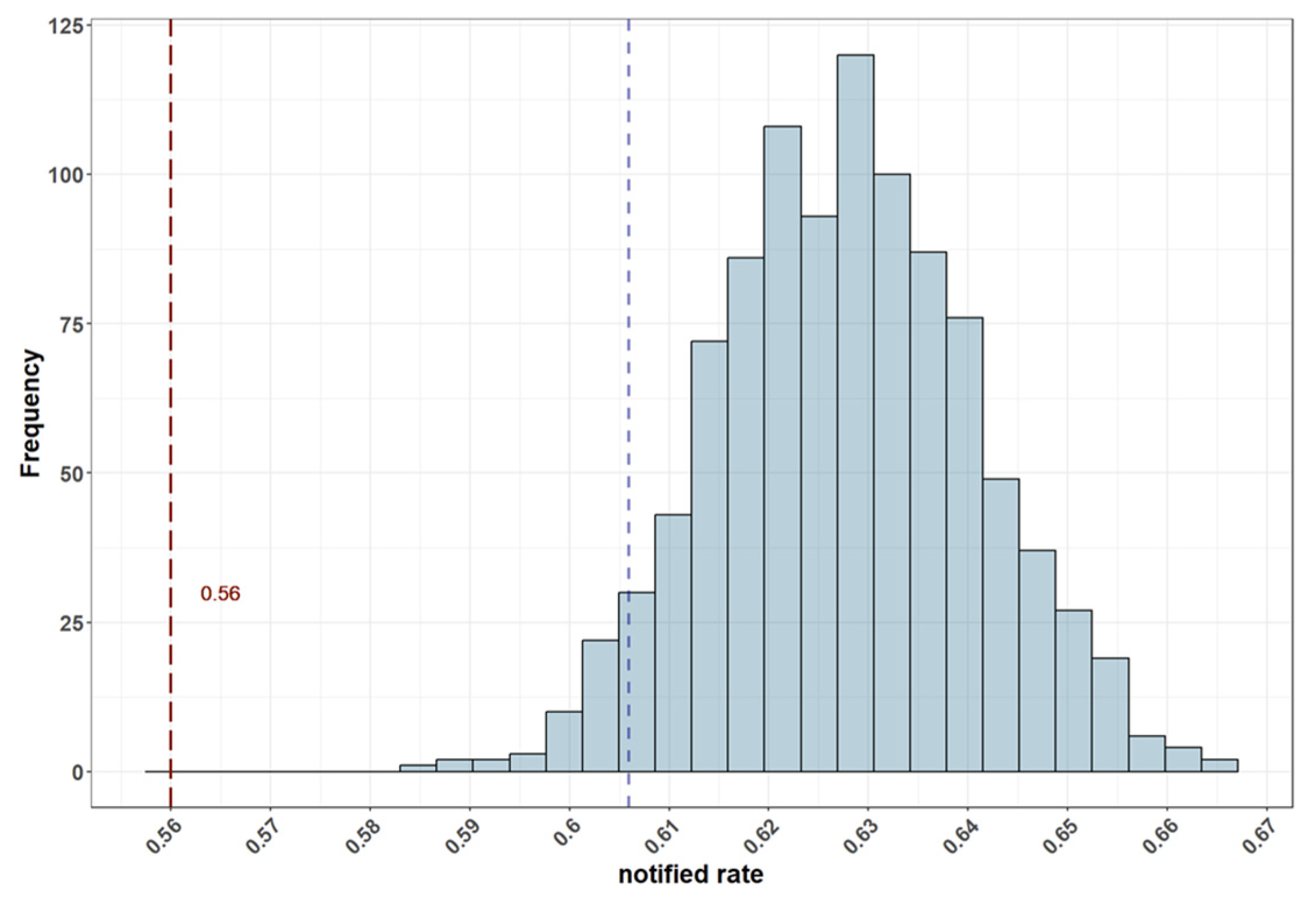

Disclaimer/Publisher’s Note: The statements, opinions and data contained in all publications are solely those of the individual author(s) and contributor(s) and not of MDPI and/or the editor(s). MDPI and/or the editor(s) disclaim responsibility for any injury to people or property resulting from any ideas, methods, instructions or products referred to in the content. |
© 2024 by the authors. Licensee MDPI, Basel, Switzerland. This article is an open access article distributed under the terms and conditions of the Creative Commons Attribution (CC BY) license (https://creativecommons.org/licenses/by/4.0/).
Share and Cite
Kim, H.; Lee, S.; Jun, C. Analyzing the Problems of a District-Based Administration Using Monte Carlo Simulation: The Case of Sex Offender Notifications in Korea. ISPRS Int. J. Geo-Inf. 2024, 13, 177. https://doi.org/10.3390/ijgi13060177
Kim H, Lee S, Jun C. Analyzing the Problems of a District-Based Administration Using Monte Carlo Simulation: The Case of Sex Offender Notifications in Korea. ISPRS International Journal of Geo-Information. 2024; 13(6):177. https://doi.org/10.3390/ijgi13060177
Chicago/Turabian StyleKim, Hyemin, Suyun Lee, and Chulmin Jun. 2024. "Analyzing the Problems of a District-Based Administration Using Monte Carlo Simulation: The Case of Sex Offender Notifications in Korea" ISPRS International Journal of Geo-Information 13, no. 6: 177. https://doi.org/10.3390/ijgi13060177





